
The three primary trends based on the Dow theory explain the market movements. The three primary trends are upward, downward and sideward trends. Dow theory says that the primary trend is the major, long-term trend of the market, which can last for several years. It is characterized by a series of higher highs and higher lows in an uptrend, or lower highs and lower lows in a downtrend. The three phases that happen within the primary trend are Upwards, downward and sideward trends.
Understanding primary market trends are crucial for investors to make informed decisions about buying and selling stocks. It helps investors identify patterns and anticipate market movements, which can be used to their advantage. Investors can determine the best time to enter or exit (entry and exit points) the stock market, and organize their investment goals accordingly. Understanding stock market trends can help investors mitigate risk and reduce losses. It enables them to stay up-to-date with the latest news and developments that may affect the market.
Read on to find out more about the three primary trends.
1. Uptrend
An uptrend in financial markets refers to a sustained upward movement in the prices of assets over a period of time. The overall direction of the asset’s price is upward in an uptrend, indicating a bullish sentiment among investors. One of the key features of an uptrend is that every market high is higher than the previous high, indicating a consistent pattern of growth.
Traders and investors can profit from rising asset prices during an uptrend, as buying assets at lower prices and selling them at higher prices can generate profits. It’s important to note that the uptrend is not broken unless a high is lower than the previous high, indicating a possible reversal in the trend. It’s important to monitor the trend closely to identify possible trend reversals and manage risk accordingly.
One way to identify an uptrend is to use trendlines, which are lines drawn on a price chart that connect two or more price points. The trendline will slope upward and can be used to identify potential support levels where traders may look to buy assets. Trendlines can also be used to spot possible trend reversals when the price breaks below the trendline, indicating a potential shift in market sentiment. The below graph is an example of the same.

2. Downtrend
A downtrend in financial markets is the opposite of an uptrend, characterized by a gradual reduction in the price or value of a stock or commodity over a period of time. A downtrend is characterized by peaks that are lower than the previous ones, and the troughs are also lower than the previous ones, indicating a consistent pattern of decline. This decline in prices or values can represent something more than a random losing streak and may mark a fundamentally deteriorating condition.
The chain of lower lows and lower highs will continue until it is broken. Changes from an uptrend to a downtrend are observed closely by traders and investors as they can indicate a significant shift in market sentiment. Traders often use technical indicators and chart patterns to confirm a downtrend. One common sign of a downtrend is when the price action falls below the most recent trough, and the next peak fails to rise higher than its predecessor. The downward trend increases its likelihood of continuing when this occurs,. Refer to the picture below.
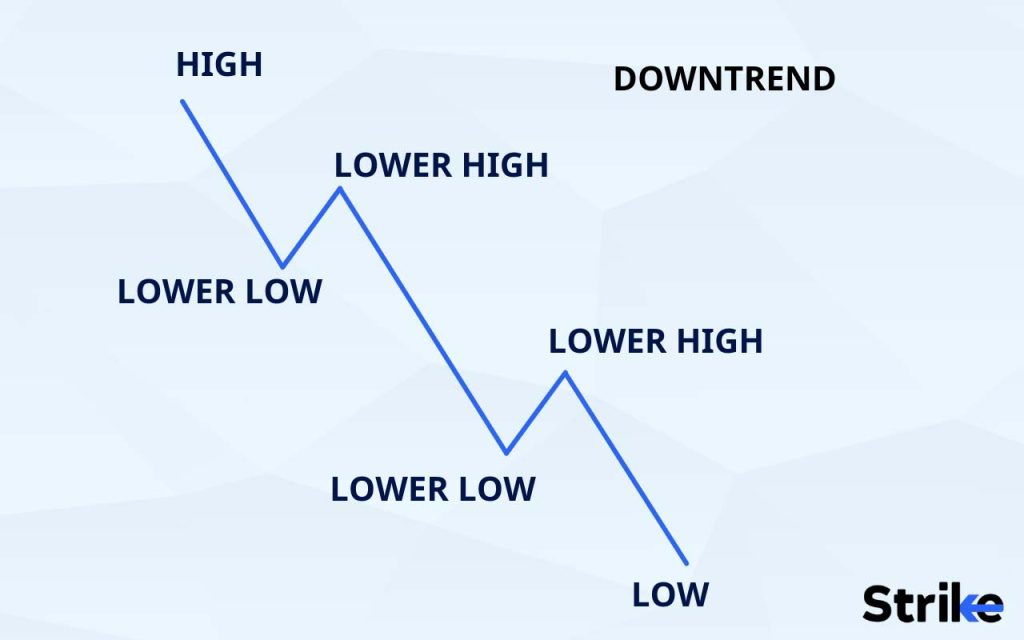
Short sellers can profit from downtrends by selling stocks or commodities that they don’t own and buying them back at a lower price, generating a profit. It’s important to note that short selling is a high-risk strategy and should only be used by experienced traders.
Identifying and understanding downtrends can be valuable for traders and investors seeking to profit from declining asset prices. It’s important, however, to remember that downtrends can indicate a fundamentally deteriorating condition, and traders should manage risk carefully.
3. Sideways trend
A sideways trend is a market situation when the price of a security trades within a reasonably stable range without forming any clear trends over time. Sideways trends are also known as a drift, signifying how the price charts behave during the time period.
A sideways market is one with relatively horizontal price movements when supply and demand parameters are equal. Price movement between strong levels of support and resistance typically leads to sideways markets.
Sideways markets may also be referred to as choppy or non-trending markets if there are several swings up and down yet they keep returning to some average level. Sideway trends can be particularly irritating for short-term traders and trend traders because there is no obvious directional trend.
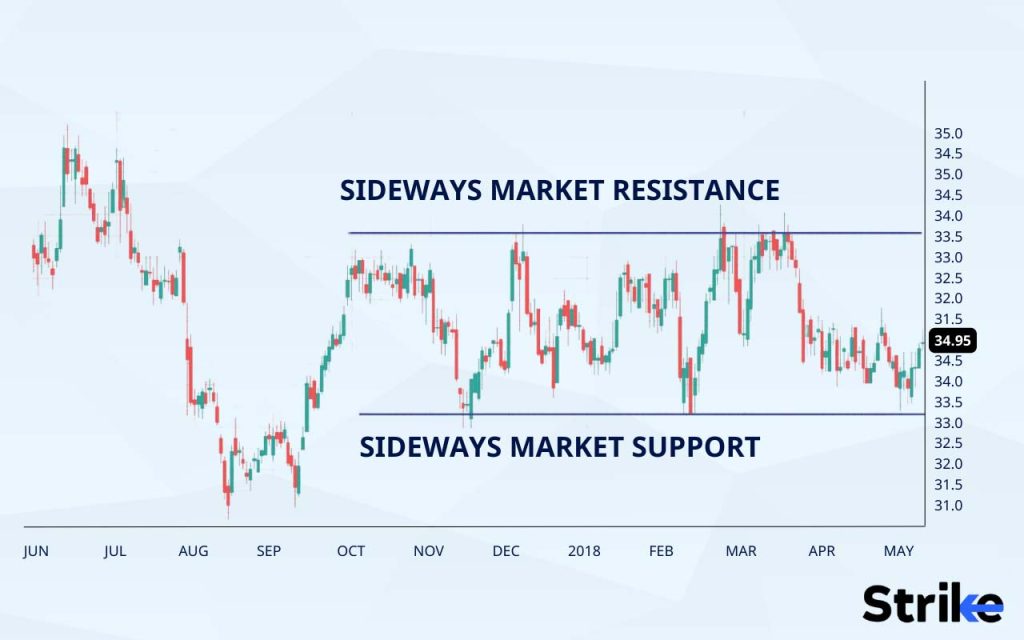
A sideways market makes it harder for day traders to generate profits. That is an encouraging sign for individuals who are more inclined to purchase and hold. The market will reveal its next course of action with time. It is crucial to maintain vigilance when the economy has been in any phase of the business cycle for an extended period of time. A trendline that represents the sideways market is shown as below.
What is Primary Trend?
The primary trend is the longest of the three major categories of dow theory, typically lasting months to years. The primary trend is a representation of investor sentiment. The dominant upward trend is referred to as the Bull Trend, whereas the primary negative trend is referred to as the Bear Trend. Investors should place the utmost importance on accurately identifying the primary trend. It is evaluated on weekly and monthly charts and depicts the general price trend over the long period.
The primary trend is established based on Dow theory. The Dow Theory is a trading strategy created by Charles H. Dow, who, along with Edward Jones and Charles Bergstresser, founded Dow Jones & Company, Inc. in 1896 and created the Dow Jones Industrial Average. In a series of editorials for the Wall Street Journal, which he co-founded, Dow elaborated on his theory.
Why Trends are Important for Forecasting?
Forecasting trends in the stock market is important because it helps investors make informed decisions about buying or selling stocks. Investors can try to predict future trends and make strategic investment decisions by analyzing past performance and current market conditions. This can help them maximize their returns and minimize their risks.
Forecasting trends in the stock market rely on factors including economic indicators, company performance, global events, and investor sentiment. Investors can gain insights into the overall health of the market and individual companies by analyzing trends.
Forecasting trends in the stock market can help investors identify potential opportunities before they become widely known. This can give them a competitive advantage and help them achieve higher returns.
What are the Benefits of the Primary Trends?
The primary trend in the stock market refers to the long-term direction of the market. It is an important concept for investors to understand because it can have a significant impact on investment decisions. Here are three benefits of primary trends in the stock market.
Better investment decisions: Understanding the primary trend of the stock market can help investors make better investment decisions. For example, investors may want to consider buying stocks if the primary trend is bullish, while they may want to consider selling or shorting stocks if it is bearish.
Reduced risk: Investing in line with the primary trend can help reduce risk. It is less risky to buy stocks if the primary trend is bullish than if the primary trend is bearish.
Increased returns: Investing in line with the primary trend can also increase returns. Investors may be able to take advantage of the upward momentum in the market to generate higher returns if the primary trend is bullish.
Understanding the primary trend in the stock market is crucial for making informed investment decisions. It can help reduce risk and increase returns, providing investors with a more strategic and profitable approach to investing.
What are the Rules for a Significant Trend?
Rules to identify significant trends will help investors double-check their strategies before investing. Below are six rules for a significant trend.
- The trend should have a clear direction, either upward or downward.
- The trend should be consistent over time, without any significant fluctuations or sudden changes in direction.
- The trend should be based on a significant sample size of data, to ensure that it is not just a random blip in the data.
- The trend should be statistically significant, meaning that there is a low probability that it occurred by chance.
- The trend should be meaningful in the context of the data being analyzed, and should not be based on outlier data points or anomalies.
- The trend should be supported by other indicators or data points, such as related trends in other areas or supporting economic or social factors.
Following these six rules can help investors identify significant trends and make more informed investment decisions. It is important to thoroughly research and analyze data to ensure that the trend is not just a random fluctuation or anomaly.
What is the Psychology of Price Movement?
The psychology of price movement is a complex field that involves understanding the factors that influence how individuals and groups make decisions about buying and selling financial assets. The psychology of price movement is about understanding how emotions, biases, and cognitive processes impact market behavior.
One of the key drivers of price movement is the concept of supply and demand. A high demand for a particular asset causes its price to increase as buyers compete to purchase the limited supply available. Low demand for an asset causes its price to decrease as sellers compete to unload their holdings.
There are other factors that can influence price movements as well. For example, news events, such as political developments or changes in economic data, can cause sudden shifts in market sentiment that impact asset prices. Psychological factors like fear, greed, and herd mentality can also play a role in driving price movements.
What is Trend Trading?
Trend trading is a trading strategy that involves identifying the direction of a market trend and making trades based on that trend. Traders aim to profit from the momentum of a market, buying when prices are rising and selling when prices are falling in trend trading.
Traders typically use technical analysis tools such as moving averages, trendlines, and price patterns to identify a trend. Traders will look for opportunities to enter the market in the direction of the trend, using stop-loss orders to limit their risk once a trend has been identified.
Trend trading can be used in any market, including stocks, forex, and commodities. It is a popular strategy among both short-term and long-term traders, as it can be used to capture both short-term and long-term trends.
Trend trading is not without its risks. Traders who are heavily invested in that trend can suffer significant losses if a trend suddenly reverses, It is important for trend traders to have a solid understanding of technical analysis and risk management strategies.
What are the Trend Trading Strategies?
Trend trading is a popular trading strategy that involves identifying and following an established trend in the market. Trend trading is often done with the help of technical indicators. Here are three of the most common trend trading strategies using technical indicators.
1. The MACD Trading Indicator
Moving average convergence/divergence (MACD) is a trend following momentum indicator that displays the connection between two exponential moving averages (EMAs) of a security’s price. Moving Average Convergence/Divergence is utilized mostly for trading trends. MACD appears as two lines that fluctuate without limits in a graph.
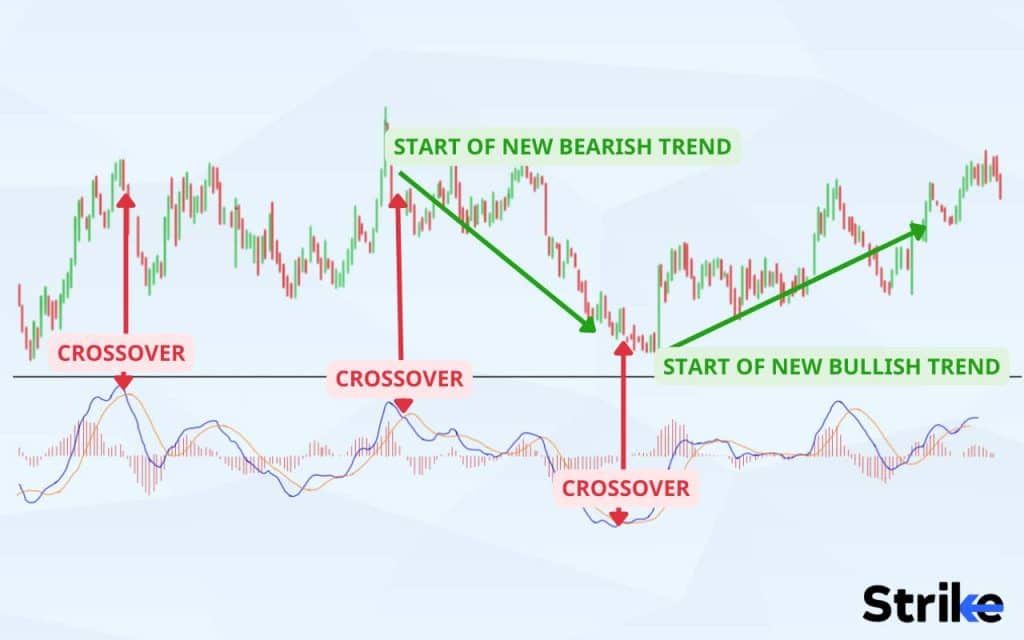
The MACD is computed by subtracting the value of a 26-period exponential moving average from a 12-period EMA, assuming conventional time intervals. Both moving averages use the period’s closing prices. The formula for the MACD signal line:
Signal line = 9-day Exponential Moving Average of the MACD line
The signal line is the MACD line’s 9-day exponential moving average. The combined examination of the signal line and the MACD line assist in identifying probable reversals or entry and exit positions, particularly when they occur at the chart’s extremes (far above or far below the zero line). The MACD formula for histograms: Histogram of MACD = MACD line – signal line. The MACD histogram depicts the gap between MACD and the signal line. It is determined by subtracting the two values. The histogram is a bar graph, making it easy to read and grasp visually.
One trend trading strategy using the MACD involves looking for bullish or bearish crossovers between the MACD line and the signal line. It is considered a bullish signal when the MACD line crosses above the signal line, indicating that the momentum is shifting to the upside.
It is considered a bearish signal, indicating that the momentum is shifting to the downside when the MACD line crosses below the signal line.
A trader would first need to plot the MACD on their price chart. They would then look for bullish or bearish crossovers between the MACD line and the signal line. The trader may consider opening a long position or adding to an existing long position if a bullish crossover occurs. The trader may consider opening a short position or adding to an existing short position if a bearish crossover occurs.
2. The ADX Indicator
ADX (Average Directional Index) is a technical analysis indicator that measures the strength of a trend. The ADX is usually plotted as a line on a chart with values ranging from 0 to 100.
An ADX line below 20 indicates a weak trend, and a line above 40 indicates a strong trend. Traders can use the ADX to help determine whether a security is trending or in a range-bound market.
The ADX is calculated by taking the difference between the +DI (positive directional indicator) and the -DI (negative directional indicator) and dividing by the sum of the two. The resulting value is then smoothed over a specified number of periods, usually 14.
One way to use ADX for trend trading is to look for a strong trend when the ADX reading is above 25. ADX above this level indicates that the trend is gaining momentum and there is a higher probability of it continuing. Traders can look for entry signals in the direction of the trend at this point. This can be done using other technical indicators or price action analysis.
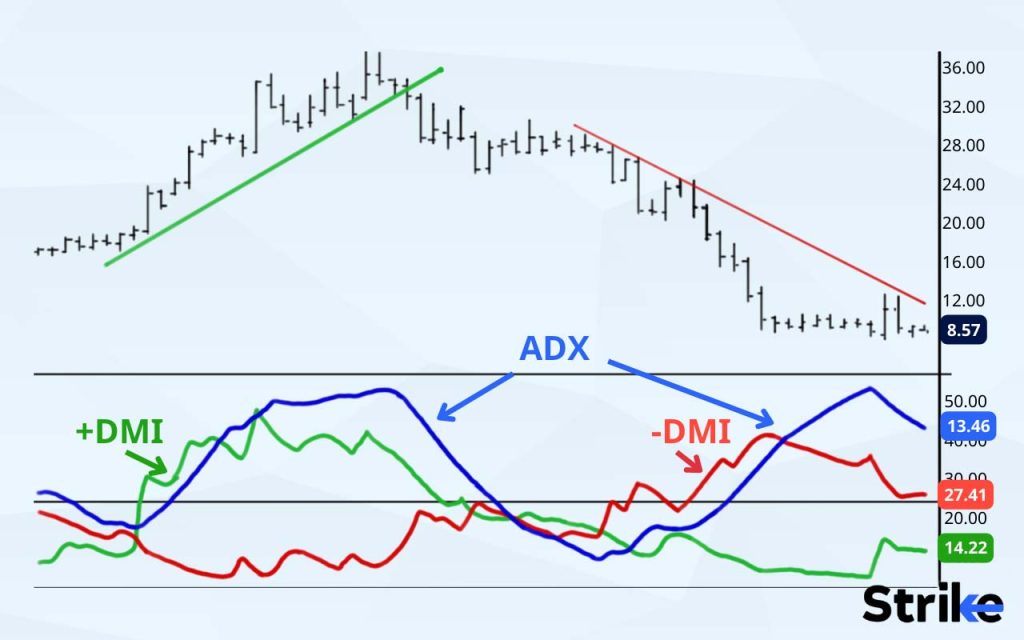
For example, suppose the trend is up and the ADX reading is above 25. Traders can look for bullish candlestick patterns or buy signals from other indicators such as moving averages. Traders can look for bearish candlestick patterns or sell signals from other indicators if the trend is down and the ADX reading is above 25.
Traders can also use the ADX to manage their trades by setting stop loss orders. Traders set their stop loss orders closer to the entry price to minimize losses in case the trend reverses.
3. The RSI Trading Indicator
The Relative Strength Index (RSI) is a technical indicator used in financial markets to measure the strength and momentum of price movements of a security over a specified period of time. The RSI is calculated using mathematical formulas that analyze the average gains and losses in the price of a security over a particular time frame, typically 14 days. The RSI is expressed as a value between 0 and 100, with readings above 70 indicating that a security is overbought and readings below 30 indicating that a security is oversold. Traders use the RSI to identify potential buy or sell signals, as well as to confirm trends and support and resistance levels. The RSI is a popular tool among technical analysts and is used in many trading strategies.
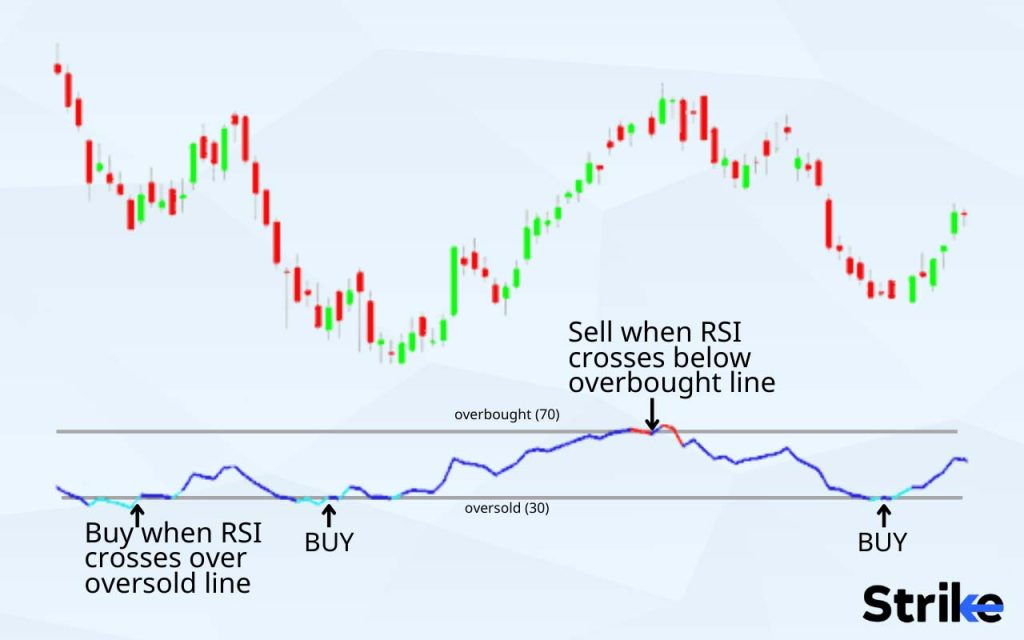
Follow these steps to use RSI for trend trading.
Identify the trend: It is important to first identify the trend of the asset you want to trade. You can do this by analyzing the price action and using other technical indicators like Moving Averages or Trendlines.
Set the RSI period: The default RSI period is 14, but you can adjust it based on your trading style and the asset you are trading. A shorter period will be more sensitive to price changes, while a longer period will be smoother.
Check for overbought and oversold levels: The RSI considers an asset overbought when it reaches 70 or above and oversold when it reaches 30 or below. RSI reaching these levels suggests the asset may be due for a reversal.
Look for divergences: Divergences occur when the RSI and price action move in opposite directions, indicating a potential trend reversal. Bullish divergence occurs when the price makes a lower low, but the RSI makes a higher low, while bearish divergence occurs when the price makes a higher high, but the RSI makes a lower high.
RSI should not be used in isolation but rather as a confirmation tool for other indicators and price action. For example, you can use RSI to confirm the reversal and enter the trade if you identify a trend reversal using other indicators or price action.
Why Trend Trading is Important?
Trend trading is important for three main reasons. The reasons are listed below.
Capturing long-term trends: Trend trading is a strategy that aims to capture long-term trends in the market. Traders can position themselves to profit from these trends as they develop over time by identifying trends early on.
Reducing risk: Trend trading can help reduce risk by allowing traders to enter and exit positions at key points in the trend. Traders can reduce their exposure to market volatility and potential losses by entering a position when the trend is beginning and exiting when it is ending.
Maximizing returns: Trend trading can help traders maximize their returns by allowing them to ride the trend for as long as possible. Traders can capture the majority of the gains associated with that trend by staying in a position for the duration of the trend.
Providing market insights: Trend trading can provide valuable insights into the market, including information about market sentiment and investor behavior. Traders can gain a better understanding of market dynamics and make more informed trading decisions by analyzing trends and patterns in the market.
How to Identify Market Trends?
Identifying market trends is an important skill for any investor in the stock market. Here are four ways to identify market trends.
Technical analysis: This involves analyzing charts and using indicators to identify patterns and trends in stock prices. Technical analysis can help you identify support and resistance levels and potential trend reversals.
Fundamental analysis: This involves analyzing a company’s financial statements, economic indicators, and other factors that can impact its stock price. Fundamental analysis helps you identify trends in earnings, revenue, and other financial metrics that can impact the stock price.
News and events: Keeping up with news and events that can impact the stock market can help you identify trends. For example, if there is news of a major merger or acquisition, this could impact the stock prices of the companies involved.
Market sentiment: Monitoring market sentiment can help you identify trends. This involves analyzing investor sentiment and behavior, such as buying and selling patterns and the level of market participation.
It’s important to note that market trends can be difficult to predict, and there is no foolproof method for identifying them. It’s important to do your research and stay informed about market conditions to make informed investment decisions.
How Does Dow Theory Work?
Dow Theory is a form of technical analysis used to analyze and predict market trends. Dow theory was developed by Charles H. Dow, who was also the co-founder of Dow Jones & Company and the creator of the Dow Jones Industrial Average (DJIA).
The basic premise of Dow Theory is that the stock market is made up of three types of trends: primary trends, secondary trends, and minor trends. Primary trends are long-term trends that last for more than a year and are the most important trends to follow. Secondary trends are shorter-term trends that last a few weeks to a few months and are considered to be corrections within the primary trend. Minor trends are the shortest-term trends that last a few days to a few weeks and are often caused by market noise.
What are Dow Theory’s Main Components?
Dow Theory is a fundamental approach to technical analysis that is widely used to analyze stock market trends. It was developed in the late 19th century by Charles Dow, the founder of the Wall Street Journal and one of the pioneers of modern financial journalism. The theory consists of six main components. Of which, the three main components are below.
The market discounts everything: Dow believed that all information about a company and its stock price is already reflected in the market. Technical analysts should focus on the price movement of the stock rather than on the company’s financial statements.
The market has three trends: Dow identified three types of market trends: the primary trend, which can last for several years and is the most important; the secondary trend, which is a correction of the primary trend and can last from a few weeks to a few months; and the minor trend, which is short-term and can last from a few days to a few weeks.
The primary trend has three phases: Dow believed that the primary trend has three phases: the accumulation phase, where smart money buys stocks before the stock price rises; the public participation phase, where the general public buys stocks and the market rises rapidly; and the distribution phase, where smart money sells stocks before the stock price falls.
Dow Theory provides a comprehensive framework for analyzing stock market trends and is a useful tool for technical analysts through these components.
Is Sideways Trend and Long-Term Trend the same?
No, Sideways Trend and Long-Term Trend are not the same.
A Sideways Trend, also known as a horizontal trend or a range-bound market, occurs when the price of an asset moves within a relatively narrow price range for an extended period. The asset’s price remains relatively flat with no clear direction, moving neither upward nor downward. Traders often refer to this as a period of consolidation or a lack of volatility.
A Long-Term Trend describes the overall direction of an asset’s price movement over an extended period. It can be upward, downward, or flat, and can last for several months, years, or even decades. Traders and investors use long-term trends to identify potential buying or selling opportunities and to make informed decisions about their investments.
Can I Use ROC for Long-Term Market Trends Analysis?
No. ROC, or Rate of Change, is a technical analysis indicator that measures the percentage change in an asset’s price over a specified period. ROC may not be the best indicator for analyzing long-term market trends and it works better for short-term.



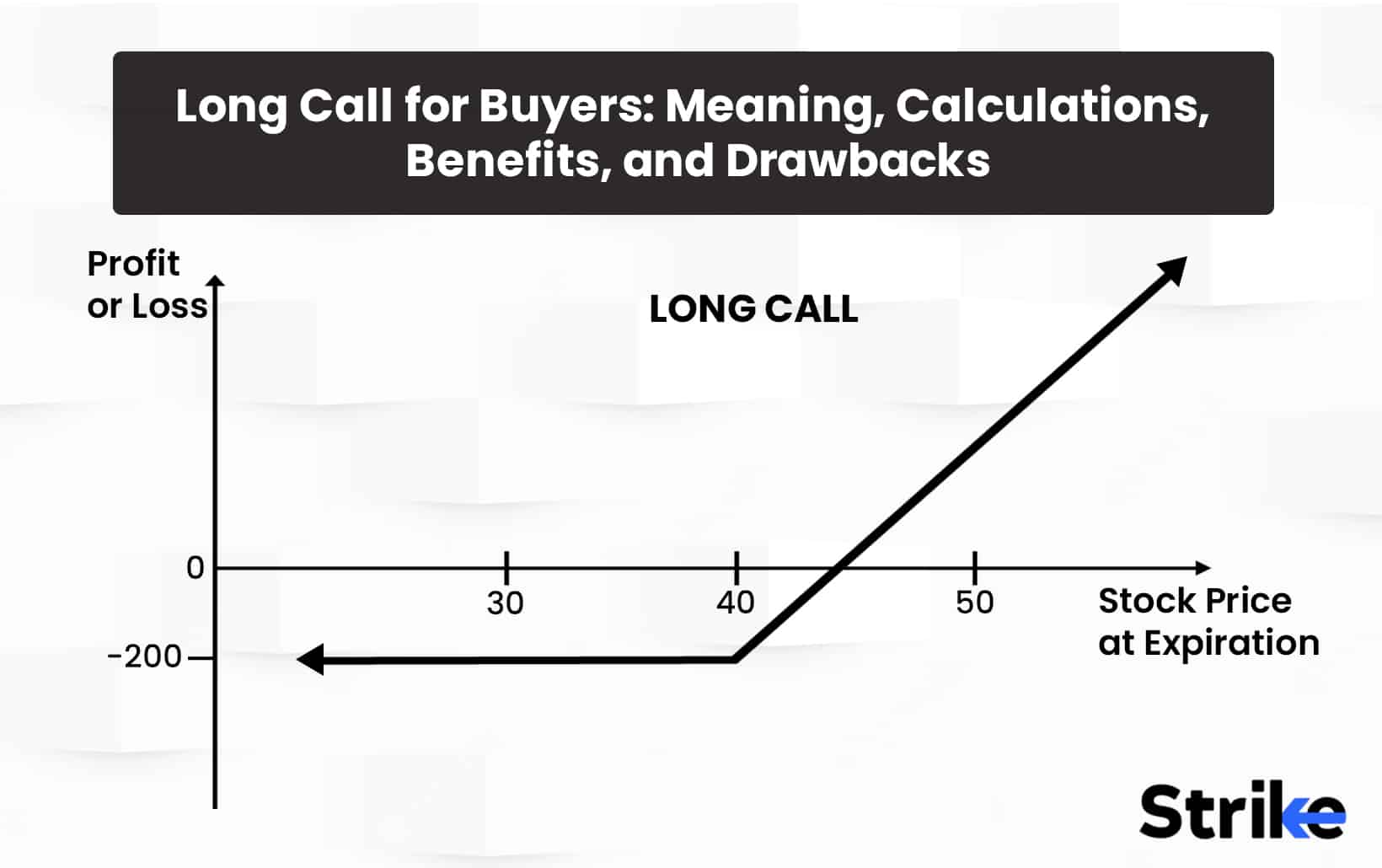
![85 Common Stock Market Terminologies for Dummies [Updated List for 2025] 70 85 Common Stock Market Terminologies for Dummies [Updated List for 2025]](https://www.strike.money/wp-content/uploads/2025/04/Popular-Stock-Market-Terms-for-Beginners-Banner.png)











No Comments Yet.